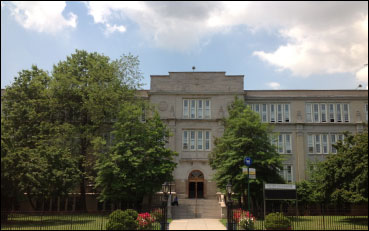 March 13, 2013 CONTACT: Chris Gilbride / Ted Timbers (718) 595-6600 Department of Environmental Protection Begins Water Conservation Program at 500 City SchoolsUpdating Bathroom Fixtures Will Reduce Citywide Water Consumption by Approximately Four Million Gallons Each DayNew York City Department of Environmental Protection (DEP) Commissioner Carter Strickland today announced that DEP has begun a program to install new, high efficiency fixtures in the bathrooms of 500 City schools to reduce water consumption by nearly four million gallons each school day. The water conservation project is part of New York City’s Water for the Future Program, a $2.1 billion initiative to ensure clean, reliable, and safe drinking water for nine million New Yorkers for decades to come. As part of the Program, DEP will repair leaks in the Delaware Aqueduct that supplies roughly half of the city’s daily drinking water needs. In order to make repairs to the Aqueduct, the tunnel must be temporarily shut down between 2020 and 2021. In addition to supplementing the city’s water supply during the shutdown, DEP aims to reduce citywide water consumption by five percent through conservation programs. Demand reduction initiatives complement the historic $10.5 billion invested in water supply infrastructure since Mayor Bloomberg took office in 2002. “The critical investments we are making today will help ensure the growth and prosperity of New York City for decades to come,” said Commissioner Strickland. “Providing a reliable supply of high quality drinking water requires enhancing our delivery system and reducing demand and waste. As we anticipate activating new facilities to treat and deliver drinking water, it makes sense to also conserve water and the amount of energy required to treat it. In addition, reducing water consumption will also create additional capacity in local sewer systems, which will help prevent street flooding during heavy rain and ease pressure on the city’s wastewater treatment plants.” The retrofit program began as a pilot in 2012 at Hillcrest and Bayside High Schools in Queens, where the installation of 350 high efficiency toilets has been completed. This year, 23 additional schools will be upgraded with high efficiency bathroom fixtures and retrofits at 500 schools are scheduled to be completed by 2018. Overall, the project will upgrade nearly 40,000 bathroom fixtures and is projected to reduce citywide water consumption by approximately four million gallons per day. The approximately $31 million retrofit project is being funded by DEP. In November 2010, DEP announced the Water for the Future Program and later this year ground will be broken on two 800 foot deep shafts and a 2.5-mile bypass tunnel around a portion of the Delaware Aqueduct that is leaking in Roseton in Orange County. The project will also include repair work to fix leaks in Wawarsing, in Ulster County, from the inside of the existing tunnel. The three-mile bypass tunnel will run east from the Town of Newburgh in Orange County, under the Hudson River to the Town of Wappinger in Dutchess County, on the east side of the Hudson. The construction of the bypass tunnel and the repair of the tunnel lining will ensure that DEP can continue to deliver high quality drinking water every day for decades to come. As part of the Water for the Future initiative, DEP developed the Municipal Water Efficiency Program to identify opportunities to conserve water at City-owned properties and facilities. As part of this program, DEP has already begun a partnership with the New York City Department of Parks and Recreation to install activation buttons on spray showers in 400 playgrounds around the city that will save 1.5 million gallons of water a day. The goal of the Municipal Water Efficiency Program and DEP’s other conservation efforts is to reduce citywide water consumption by five percent. In addition to partnerships with the Department of Education and the Parks Department, later this year DEP will begin a voucher-based program to replace roughly 800,000 outdated residential toilets with high efficiency models. The new toilet rebate program will build on the success of a similar rebate program that ran from 1994 to 1997 and replaced 1.3 million toilets and reduced citywide water consumption by 90 million gallons per day. High-efficiency toilets use only 1.28 gallons of water per flush, compared to traditional toilets which can use as much as five gallons. As a result of those programs, the transition from frontage billing to metered billing, and the roll out of Automated Meter Readers and real-time feedback about water consumption, overall water use in the city has declined from over 1.5 billion gallons a day in 1980 to 1.1 billion gallons a day at present, while the City’s population grew from just over 7.1 million to 8.4 million in the same period. DEP manages New York City’s water supply, providing more than one billion gallons of water each day to more than nine million residents, including eight million in New York City. The water is delivered from a watershed that extends more than 125 miles from the city, comprising 19 reservoirs and three controlled lakes. Approximately 7,000 miles of water mains, tunnels and aqueducts bring water to homes and businesses throughout the five boroughs, and 7,500 miles of sewer lines and 96 pump stations take wastewater to 14 in-city treatment plants. DEP has nearly 6,000 employees, including almost 1,000 in the upstate watershed. In addition, DEP has a robust capital program, with a planned $14.4 billion in investments over the next 10 years that will create up to 3,000 construction-related jobs per year. For more information, visit nyc.gov/dep, like us on Facebook at facebook.com/nycwater, or follow us on Twitter at twitter.com/nycwater. | ||